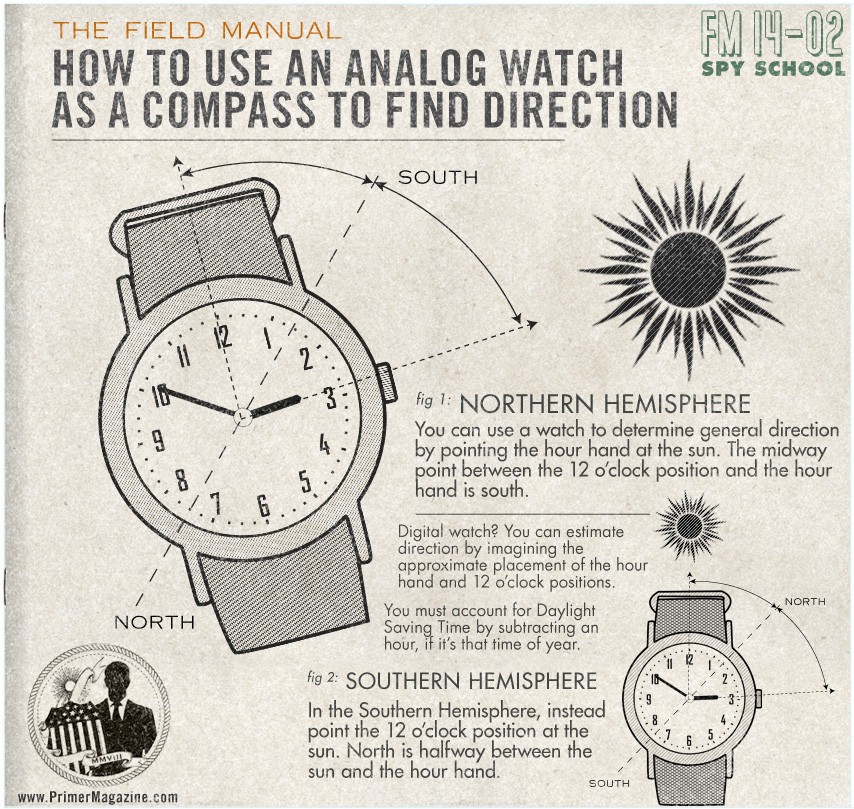How to Use Your Wristwatch as a Compass

When you’re deep in the backcountry, truly lost, and your gear is gone or useless, panic can set in fast. Maybe your phone is dead, your compass is missing, and the sun is starting to dip. But take a breath, there are ways to navigate even without traditional tools. One of the simplest and most effective methods? Your wristwatch.
Using an analog watch to find North is a time-tested trick that requires nothing more than sunlight and a little know-how. While it won’t give you a pinpoint-accurate heading, it will point you in the general right direction, enough to keep you from walking in circles.
Find Your Bearings with a Watch
In the Northern Hemisphere
Holding your watch flat and parallel to the ground, point the hour hand (the little one) directly at the sun. Now, find the angle between the hour hand and the 12 o’clock mark on the watch face. Draw an imaginary line down the middle of that angle. That midpoint line is pointing South, so the opposite direction is North.
If your watch is set to Daylight Savings Time, adjust your reference point by using the 1 o’clock mark instead of the 12.
In the Southern Hemisphere
The process is nearly the same, but with one key difference. Instead of pointing the hour hand at the sun, point the 12 o’clock mark at it. Find the center angle between 12 and the hour hand. That midpoint line now points North, so the opposite direction is South.

How Accurate Is This Watch-Compass Method?
While the watch method isn’t precise, it provides a reliable general direction. This technique works best around midday when the sun is higher in the sky, but it can still be useful at other times.
If you combine it with other navigation tricks, like recognizing natural landmarks or using the Shadow-Stick Method, you’ll increase your chances of getting back on track. Survival is all about using every available tool, and this is just one more technique to add to your backcountry skillset.
Other Ways to Find Your Way
If you don’t have a watch or the sun is low in the sky, don’t worry. There are multiple ways to navigate using natural elements.
The Shadow-Stick Method
One of the simplest ways to determine direction using the sun is with a stick and some patience. Here’s how:
- Place a stick upright in the ground.
- Mark the tip of its shadow with a rock or another small marker.
- Wait 15–30 minutes and mark the new position of the shadow tip.
- Draw a straight line between the two points—this line runs roughly West to East.
- Stand with the first mark on your left and the second on your right—now you’re facing North.
Equal Length Shadow Method
Another effective technique using shadows is the Equal Length Shadow Method. It requires checking the sun’s shadow twice over the course of the day:
- In the morning, place a stick in the ground and mark the tip of its shadow.
- Continue checking the shadow as the day progresses.
- When the shadow reaches the same length it was in the morning, mark this new position.
- The line between the two points runs East to West, with North perpendicular to it.
Magnetized Needle Compass
If you have a needle, a bit of fabric, and a still pool of water, you can create a makeshift compass:
- Rub a needle against silk or hair to magnetize it.
- Carefully place the needle on a small leaf or a piece of lightweight material.
- Float it in a still pool of water.
- The needle will align itself with the Earth’s magnetic field, roughly pointing North-South.
This isn’t a foolproof method, but in a desperate situation, it can be a lifesaver.
Navigating by the Stars
If it’s nighttime, the sky offers another reliable way to find your direction.
- In the Northern Hemisphere, locate the Big Dipper. Its two “pointer” stars lead directly to the North Star (Polaris), which indicates true North.
- In the Southern Hemisphere, find the Southern Cross and extend its long axis about four times its length to approximate the South Celestial Pole.
Understanding how to read the night sky can be invaluable when visibility is limited and the sun isn’t available for navigation.
Keep Your Head and Keep Moving
Getting lost in the wild is always a possibility, but with the right survival knowledge, you can find your way out. The ability to navigate without a compass is an essential skill for any outdoor enthusiast.
Using your watch to find North is a simple yet effective trick that could save your life. Combine it with other natural navigation methods, stay calm, and keep moving in the right direction. Panic leads to poor decisions, but knowledge keeps you safe. You might not be able to dial 911, but at least you’ll know which way to go.
